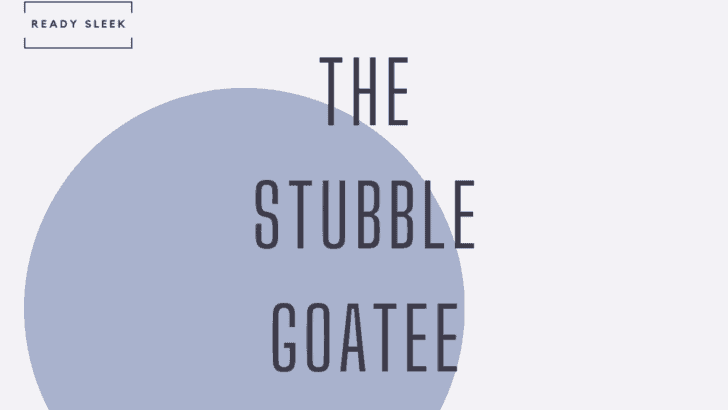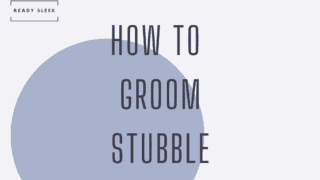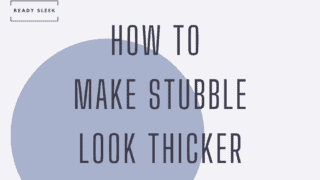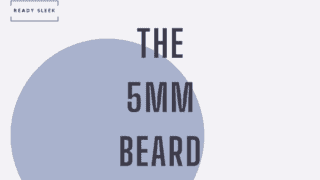You’re about to learn exactly what you need to know about the glorious stubble goatee. You’ll learn what it actually is, and then how to trim, groom, and maintain it effortlessly.
What exactly is a stubble goatee?
At this point, it would be useful to break the stubble goatee style down into its two core components – stubble, and the goatee.
The stubble
Stubble is not a style. Stubble is a length. It simply refers to facial hair of any sort that is very short. Specifically, less than 5mm long.
It can be broadly divided into light (1-2 mm), medium (3mm), and heavy (4-5mm) stubble. The length you choose is based on personal preference, experience, and experimentation. But we’ll come onto this shortly.
Now let’s talk about the goatee. Just bear in mind that a stubble goatee is simply a goatee in which the hair is very short (<5mm).
The goatee
When assessing a style and deciding whether or not it falls within the “goatee” category, the following point must be remembered.
In a goatee, there is hair on the chin but not on the cheeks.
There are many variants of the goatee, but the two to get to grips with are the “Pure Goatee” and the “Full Goatee”.
The Pure Goatee consists only of a small chin beard. Facial hair under the lip and on the chin, with no mustache and of course, no cheek hair.
The Full Goatee is far more common and more recognizable in the modern age. It is the style that first comes to mind when the word “goatee” is uttered.
In this style there is a similar chin beard, extending only as far as the corners of the mouth on each side.
But there is also a mustache that extends downwards past the corners of the mouth and connects to the chin beard beneath.
As it is the most popular, what you’re about to learn how to trim is The Full Goatee. If you do want to convert it into a Pure Goatee, simply trim and shave off the mustache. Easy.
How to trim a stubble goatee
Step 1: Grow it out
The first step is to get all of your facial hair to a workable length before trimming the stubble goatee.
If you’re a clean-shaven or almost clean-shaven man, this means growing it out to a length approximately 2mm longer than the length you ultimately want for your stubble goatee.
This will allow the slower-growing hairs to blossom before trimming it down.
Step 2: Trim the whole beard down
Grab your stubble trimmer and set it to the length you want to go for. Whether it’s light (1-2mm), medium (3mm), or heavy (4-5mm), it’s worth trying out.
If you’re unsure as to which stubble length you want, that’s fine. Simply trim down slowly in 1mm increments until you find a length you like.
That’s the beauty of starting from a length longer than what you’d like to end up with.
It also allows you to vary the length of the stubble slightly in different parts of the stubble beard. For example, with the stubble goatee, the two main areas are the mustache and the chin beard.
Your mustache may be slightly thicker than your chin hairs. In which case, you could trim the mustache down approximately 0.5 – 1mm shorter than the chin hairs to allow for a more even-looking goatee.
Just be sure to trim everything in this step. The neck, cheeks, chin, and mustache to around the same length, allowing for the slight variation mentioned above. This needs to be done before we outline the goatee.
Step 3: Trim the entire neckline
The neckline is the border between your beard and your neck skin. Neck stubble can look very unkempt, and removing it is a foundational concept in stubble shaping.
A well-defined neckline can give great definition to the jaw when sculpted properly.
In a stubble goatee, the neckline is very short and doesn’t extend past the levels of the mouth corners. But at this point, I recommend trimming the entire neckline from earlobe to earlobe, even though some of it will be removed in subsequent steps.
This is the best way to ensure your neckline doesn’t end up too high or too low. Trying to trim your goatee neckline at this point can be pretty difficult.
A neckline that’s too high can lead to an undesirable double-chin effect. If your neckline is above your jawline, you’ve done something wrong. To avoid this, find and trim your “ideal neckline” by following these steps:
- Tilt your head up. Have a look at your whole neck and the stubble that overlies it.
- Take your second and third fingers and position them horizontally above your Adam’s apple. The point immediately above the top finger is exactly “two-finger widths” above your Adam’s apple. This point is crucial, as it marks the lowest point of your neckline. Either mark it out in your head or use a pen/eyeliner to physically mark out it.
- Visualize a U-shaped curve running from earlobe to earlobe, passing through this point you just marked out. Usually, I recommend that the curve should slant upwards in either direction, roughly following the angle of the jaw. But as most of it will be trimmed off later anyway, this isn’t essential, so don’t spend too much time on it. Doing it this way will just ensure that your ultimate goatee neckline is not too high or too low.
- Outline this line and trim all the hair that lies beneath it.
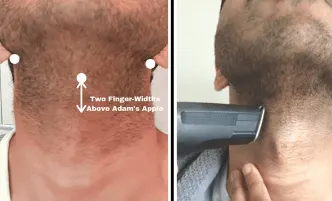
Step 4: Trim the goatee edges
It’s time to start sculpting the piece de resistance – the stubble goatee itself.
The goatee will be outlined using the naked blade of the trimmer, then sharpened up, later on, using a shaver.
Just to re-cap, The Full Goatee consists of a chin beard connected to a mustache. The facial hair encircles the mouth, which is why it’s sometimes called a Circle Beard.
An important rule to remember is to initially make the goatee a little wider than you’d first expect. This way, you can always narrow it down afterward, instead of overshooting and making it too thin, to begin with. Follow these steps to ensure you follow the best practice:
- Follow the curve of your mustache down towards your chin and past your neckline on either side. This is a basic, yet natural-looking outline for your stubble goatee. It almost creates a triangular shape for your goatee, from your nostrils down to the chin.
- Outline this shape using your trimmer. Be sure to always maintain symmetry. Remember to trim down past the neckline.
- Try to make the edges sharp and neatly defined, including the jawline area.
- Then, trim everything outside this line you’ve outlined.
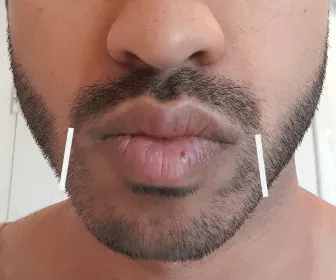
That should do it.
Ready Sleek founder. Obsessed with casual style and the minimalist approach to building a highly functional wardrobe. Also a fan of classic, vintage hairstyles.

